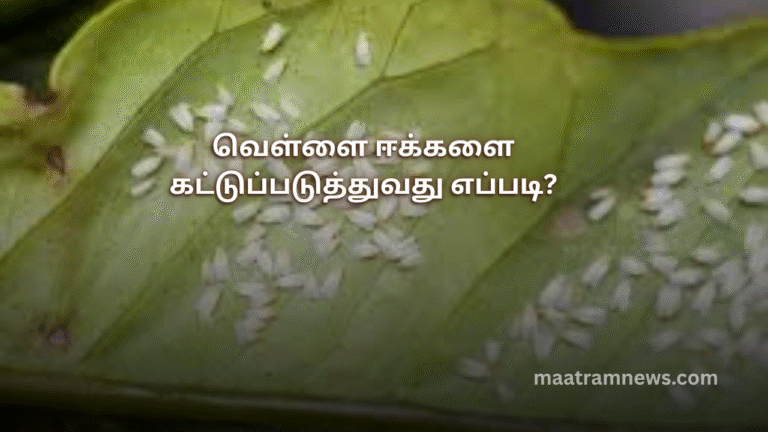வெள்ளை ஈக்களை கட்டுப்படுத்துவது எப்படி?
பொதுவாக, இரசாயனப் பூச்சிக்கொல்லியைத் தெளிக்கும்போது, சூழலுக்குப் பாதிப்பு ஏற்படுவதுடன், உணவும் நஞ்சாகிறது. இரசாயனப் பூச்சிக்கொல்லிகளின் தாக்குதலினை தொடர்ந்து எதிர்கொள்ளும் பூச்சிகள், அந்தப் பூச்சிக்கொல்லிகளுக்கு எதிரான ஆற்றலைக் கொண்ட சந்ததிகளை உருவாக்கிவிடுகின்றன. இதனால், விவசாயிகள் மென்மேலும் வீரியமான பூச்சிக்கொல்லிகளைப் பயன்படுத்த வேண்டிய கட்டாயத்துக்கு ஆளாகிறார்கள், விவசாயிகள். இதனால் எமக்குப் புற்றுநோய் ஏற்படுவதை தவிர, நிரந்தர தீர்வு கிடைப்பதில்லை.
நஞ்சற்ற முறையில், வெர்ட்டிசீலியம் லக்கானி (Verticillium Lecanii) எனப்படும் இயற்கைச் சூழலில் காணப்படும் ஓர் பூஞ்சணமானது வெள்ளை ஈ, மாப்பூச்சி, செதில்பூச்சி, மெல்லிய தோல் கொண்ட தத்திகள் போன்ற சாறு உறிஞ்சும் பூச்சிகள் மற்றும் கறையான்களை கட்டுப்படுத்துகிறது. நெல், காய்கறிகள், பூக்கள், இலைக்கறிகள், பப்பாளி போன்ற பயிர்களில் இதைப் பயன்படுத்தலாம். ஏக்கருக்கு இரண்டு லீட்டர் வெர்ட்டிசீலியம் பூஞ்சணத்தை 90 லிட்டர் தண்ணீரில் கலந்து தெளிக்கலாம். சொட்டுநீர்ப் பாசனம் மூலமாகக் கொடுப்பவர்கள், ஒரு லிட்டர் தண்ணீருக்கு 30 மில்லி என்ற அளவில் கலந்து கொடுக்கலாம்.
இலங்கையில் தனிப்பட்ட முறையில் வெர்டிசீலியம் பயன்படுத்திப் பயனடைந்த பயனர்களின் அனுபவங்களின் தொகுப்பு.
🌶️மிளகாய் உற்பத்தியில் வெர்டிசீலியம்
இலங்கை பூராகவும் உள்ள ஏற்றுமதியாளர்களின் தோட்டங்களில் பரீட்சார்த்த ரீதியாக, இதனை ஏக்கருக்கு 2 L எனும் அளவை 90 லீட்டர் நீரில் கலந்து 14 நாள் இடைவெளியில் விசிறியபோது, இலைச்சுருள் நோயை ஏற்படுத்தும் சாறு உறிஞ்சும் பூச்சிகளுக்கு எதிரான உச்சப் பலன் கிடைத்தது.
🥬வல்லாரை, கீரை, பயற்றை செய்கையில் வெர்டிசீலியம்
இலங்கை பூராகவும் உள்ள தனிப்பட்ட தோட்டங்களில் தனிப்பட்டபரீட்சார்த்த ரீதியாக, இதனை ஏக்கருக்கு 2 L எனும் அளவை 90 லீட்டர் நீரில் கலந்து 14 நாள் இடைவெளியில் விசிறியபோது, வைரஸ் நோய் காவிகளான சாறு உறிஞ்சும் பூச்சிகளுக்கு எதிரான நல்ல பலன் கிடைத்தது.
🥭மாமரத் தத்திப்பூச்சிகளினை கட்டுப்படுத்தும் வெர்டிசீலியம்
மாமரத்தின் பூக்கும் பருவத்தில் வந்து, பழம் பழுத்து ஓயும் வரை மரத்தில் தங்கிவாழும் சாறு உறிஞ்சும் பூச்சியை கட்டுப்படுத்த 14 நாட்கள் இடைவெளியில் மரம் முழுவதும் விசிறி, கீழே விழுந்து கிடக்கும் பாதிக்கப்பட்ட பழங்கள் மீதும் விசிறி பிரயோகித்த போது சிறப்பான பலன் கிடைத்தது.
🌴 தென்னையில் மைற்றா நோயை ஏக்கருக்கு 2 L எனும் அளவை 90 லீட்டர் நீரில் கலந்து தேங்காய் மற்றும்
குரும்பைகளுக்கு 3 மாதங்களுக்கு ஒருமுறை விசிறும்போது சிறப்பாக கட்டுப்படுத்துகிறது.
அத்துடன் வெள்ளை ஈயையும் ஏக்கருக்கு 3 L எனும் அளவை 90 லீட்டர் நீரில் கலந்து ஓலைகளுக்கு மாதம் ஒருமுறை விசிறும்போது சிறப்பாக கட்டுப்படுத்துகிறது.
🌾நெல் வயல் கதிர் நாவாய்ப்பூச்சி கட்டுப்பாட்டில் வெர்டிசீலியம்
வவுனியா, கிளிநொச்சி, முல்லைத்தீவு, மட்டக்களப்பு, அம்பாறை மாவட்டங்களில் உள்ள இயற்கை நெல் வயல்களில் 2015 – 2018 ம் ஆண்டுகளில் இவை, இதனை ஏக்கருக்கு 2 L எனும் அளவை 90 லீட்டர் நீரில் கலந்து 7 நாள் இடைவெளியில் இருமுறை விசிறப்பட்டு பரீட்சார்த்தமாக சோதனை செய்யப்பட்ட போது நெல் மணிகளில் பால் பிடிக்கும் நேரத்தில் வரும் கதிர் பூச்சிகள் மிகவும் வெற்றிகரமாக கட்டுப்படுத்தப்பட்டன. தற்போதும் வவுனியா, கிளிநொச்சி, மன்னார், முல்லைத்தீவு, யாழ் மாவட்ட நெல் விவசாயிகள் இதனைத் தொடர்ந்து பயன்படுத்தி வருவதாக அறியமுடிகிறது.
இவை யாவும் இயற்கை விவசாயத்தில் நஞ்சற்ற இயற்கை பீடை கொல்லியாக ஐரோப்பிய, இந்திய மற்றும் கிழக்காசிய நாடுகளால் முறையான பரிசோதனைகளின் பின் அங்கீகரிக்கப்பட்டவை. மேலும் இந்திய சந்தைகளில் இவை பரவலாக, மாநில அரசுகளுக்கூடாக இலகுவாக கிடைப்பதுடன் அங்குள்ள இயற்கை விவசாயிகளால் சிறப்பான முறையில் வெற்றிகரமாக பயன்படுத்தப்பட்டு வருகின்றன.
இலங்கையிலும், அரசாங்கமானது, நஞ்சு உற்பத்தி இறக்குமதி நிறுவனங்களின், இரசாயன மற்றும் நஞ்சு வர்த்தக அழுத்தங்களுக்கு அடிபணியாது, இந்திய இயற்கை விவசாயத்தை ஓர் மாதிரியாகக் கொண்டு இவற்றை மிக விரைவில் அங்கீகரிப்பதானது, நஞ்சற்ற விவசாயத்தினை அடுத்த கட்டத்திற்கு உயர்த்தி, இயற்கை விளைபொருட்களின் விலையை குறைத்து, ஏழைகளுக்கும் நஞ்சற்ற உணவு சென்றடைய நிச்சயம் வழிசமைக்கும்.
மேலதிக விபரங்களுக்கு
CSJ Agri
076 225 0017
மேலதிக தகவல்களுக்கு மாற்றம் செய்திகள் இணையத்தளத்தினுள் பிரவேசியுங்கள்.
மேலதிக தகவல்களை உடனுக்குடன் பெற்றுக்கொள்ள மாற்றம் செய்திகள் முகநூல் பக்கத்தை பின்தொடரவும்.
How to Control Whiteflies
Generally, when chemical pesticides are sprayed, they not only harm the environment but also make food toxic. The pests that continuously face pesticide attacks develop resistance and pass it on to their offspring. As a result, farmers are forced to use stronger and stronger pesticides. This not only increases the risk of cancer for us but also never provides a permanent solution.
As a non-toxic method, a natural fungus called Verticillium Lecanii helps control whiteflies, aphids, scale insects, mealybugs, and other sap-sucking pests. This can be used in paddy, vegetables, flowers, leafy greens, papaya, and many other crops. For foliar spray, 2 liters of Verticillium Lecanii should be mixed with 90 liters of water per acre. For drip irrigation, 30 ml per liter of water can be applied.
Below are collections of real experiences from users in Sri Lanka who have successfully used Verticillium Lecanii:
🌶️ Chili Cultivation with Verticillium
In experimental trials across Sri Lankan export-oriented chili plantations, 2 liters per acre mixed in 90 liters of water and sprayed at 14-day intervals gave excellent results against sap-sucking insects that cause leaf curl disease.
🥬 Gotu Kola, Greens, and Beans Cultivation
In household gardens across Sri Lanka, trials using 2 liters per acre in 90 liters of water sprayed at 14-day intervals showed effective control of virus-carrying sap-sucking insects.
🥭 Mango Tree Sap-Sucking Insects
During the flowering and fruiting stage of mango, spraying at 14-day intervals over the whole tree, as well as on fallen affected fruits, gave very good results in controlling pests.
🌴 Coconut – Mite Disease & Whiteflies
For mite disease in coconuts and areca nuts, spraying 2 liters per acre in 90 liters of water every 3 months was effective.
For whiteflies, spraying 3 liters per acre in 90 liters of water once a month on leaves gave excellent results.
🌾 Paddy – Controlling Rice Earhead Bug
Between 2015–2018, natural paddy fields in Vavuniya, Kilinochchi, Mullaitivu, Batticaloa, and Ampara districts tested Verticillium Lecanii. By spraying 2 liters per acre in 90 liters of water twice at 7-day intervals during the milky grain stage, earhead bugs were successfully controlled. Even today, farmers in Vavuniya, Kilinochchi, Mannar, Mullaitivu, and Jaffna continue to use this method.
All of these are recognized as natural, non-toxic bio-pesticides after proper testing in Europe, India, and East Asian countries. In India, they are widely available in the market, even distributed through state governments, and are successfully used by organic farmers.
In Sri Lanka, if the government avoids yielding to the pressure of pesticide import companies and chemical lobbies, and instead adopts India’s organic agriculture model, such methods can be officially approved soon. This would uplift organic farming to the next level, reduce the price of organic produce, and ensure even the poor have access to non-toxic food.
For more details:
📞 CSJ Agri – 076 225 0017



